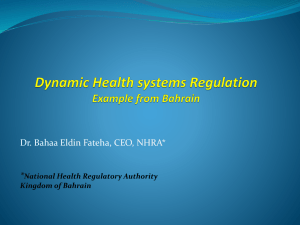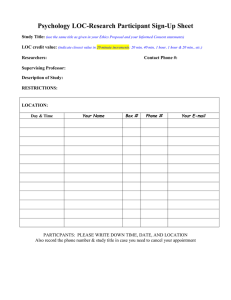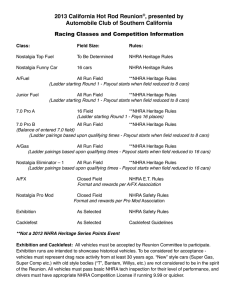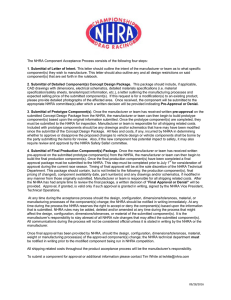nhra jr. street
advertisement
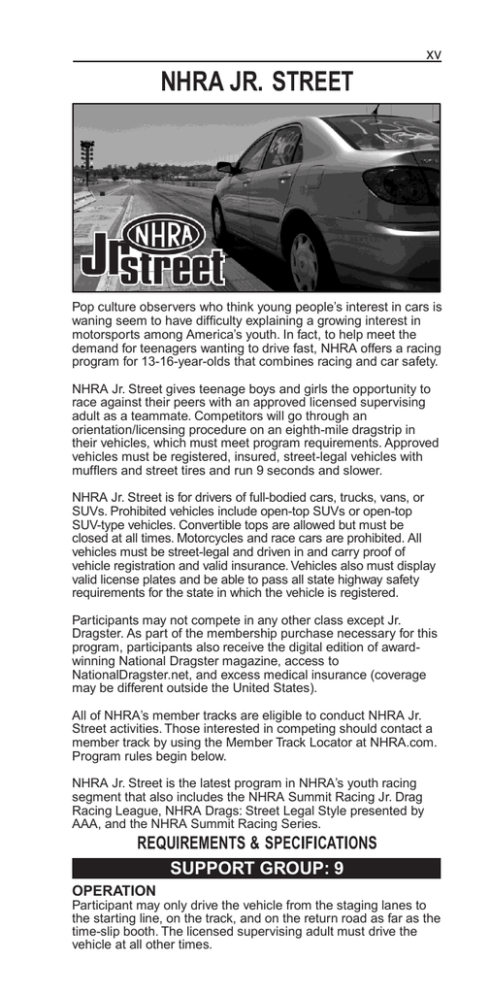
xv NHRA JR. STREET Pop culture observers who think young people’s interest in cars is waning seem to have difficulty explaining a growing interest in motorsports among America’s youth. In fact, to help meet the demand for teenagers wanting to drive fast, NHRA offers a racing program for 13-16-year-olds that combines racing and car safety. NHRA Jr. Street gives teenage boys and girls the opportunity to race against their peers with an approved licensed supervising adult as a teammate. Competitors will go through an orientation/licensing procedure on an eighth-mile dragstrip in their vehicles, which must meet program requirements. Approved vehicles must be registered, insured, street-legal vehicles with mufflers and street tires and run 9 seconds and slower. NHRA Jr. Street is for drivers of full-bodied cars, trucks, vans, or SUVs. Prohibited vehicles include open-top SUVs or open-top SUV-type vehicles. Convertible tops are allowed but must be closed at all times. Motorcycles and race cars are prohibited. All vehicles must be street-legal and driven in and carry proof of vehicle registration and valid insurance. Vehicles also must display valid license plates and be able to pass all state highway safety requirements for the state in which the vehicle is registered. Participants may not compete in any other class except Jr. Dragster. As part of the membership purchase necessary for this program, participants also receive the digital edition of awardwinning National Dragster magazine, access to NationalDragster.net, and excess medical insurance (coverage may be different outside the United States). All of NHRA’s member tracks are eligible to conduct NHRA Jr. Street activities. Those interested in competing should contact a member track by using the Member Track Locator at NHRA.com. Program rules begin below. NHRA Jr. Street is the latest program in NHRA’s youth racing segment that also includes the NHRA Summit Racing Jr. Drag Racing League, NHRA Drags: Street Legal Style presented by AAA, and the NHRA Summit Racing Series. REQUIREMENTS & SPECIFICATIONS SUPPORT GROUP: 9 OPERATION Participant may only drive the vehicle from the staging lanes to the starting line, on the track, and on the return road as far as the time-slip booth. The licensed supervising adult must drive the vehicle at all other times. xvi DRIVER: 10 AGE REQUIREMENTS Licensed participants must be at least 13 years old and may participate through the year of their 16th birthday. LICENSED SUPERVISING ADULT All runs must be made with an approved licensed supervising adult, who must be the participant’s parent or legal guardian or 25 years of age or older with a valid state driver’s license. The licensed supervising adult must be seated in the passenger seat of the vehicle anytime the participant is in the driver’s seat. The teen may only drive the vehicle from the staging lanes to the starting line, on the track, and on the return road as far as the time-slip booth. The licensed supervising adult must drive the vehicle in the pits, into the staging lanes, and must take over after the run on the return road past the time-slip booth. CREDENTIALS A valid NHRA Jr. Street program participant license and NHRA membership are mandatory. License application must be fully completed and submitted to NHRA in Glendora, Calif., for processing. License application available at NHRARacer.com. All new license applications must include a certified copy of the participant’s birth certificate and a completed and notarized minor waiver and release. Six (6) approved passes are required by the participant: a minimum of five (5) with a licensed supervising adult and one (1) with an NHRA track official, who will determine the safety and eligibility of the vehicle per elapsed time limits. After six (6) successful runs by the participant, the official and licensed supervising adult will sign the license application. An NHRA track official may deny a license to anyone he or she believes cannot handle the vehicle. If an NHRA track official denies an applicant, he or she must repeat the entire licensing procedure. As part of the licensing process, an NHRA track official also will conduct a vehicle orientation test (to demonstrate mastery of vehicle’s controls), a basic driving test (to demonstrate mastery of vehicle operation), and track orientation (to identify track fixtures, starting line, timing system, return road, time-slip booth, etc.). A vehicle orientation test is required for each vehicle entered in competition. An NHRA track official or licensed supervising adult must be in the vehicle at all times during the licensing procedure. To add a vehicle, the participant must complete a vehicle orientation test, basic driving test, and safety and eligibility vehicle test and make two (2) approved runs with a licensed supervising adult and one (1) approved run with an NHRA track official. Participant must hold an active membership in the NHRA Jr. Street program. DRIVER RESTRAINT SYSTEM Use of seat belts is mandatory for both the participant and licensed supervising adult. HELMET Helmets are mandatory for the participant and the licensed supervising adult. Helmet can be either an open-face or a fullface helmet meeting Snell M2005, M2010, K2005, SA2005, or SA2010 or SFI 31.1/2005 or 41.1/2005 certification. PROTECTIVE CLOTHING No shorts, bare legs, tank tops, or bare torsos permitted while racing (applies to both participant and licensed supervising adult).
